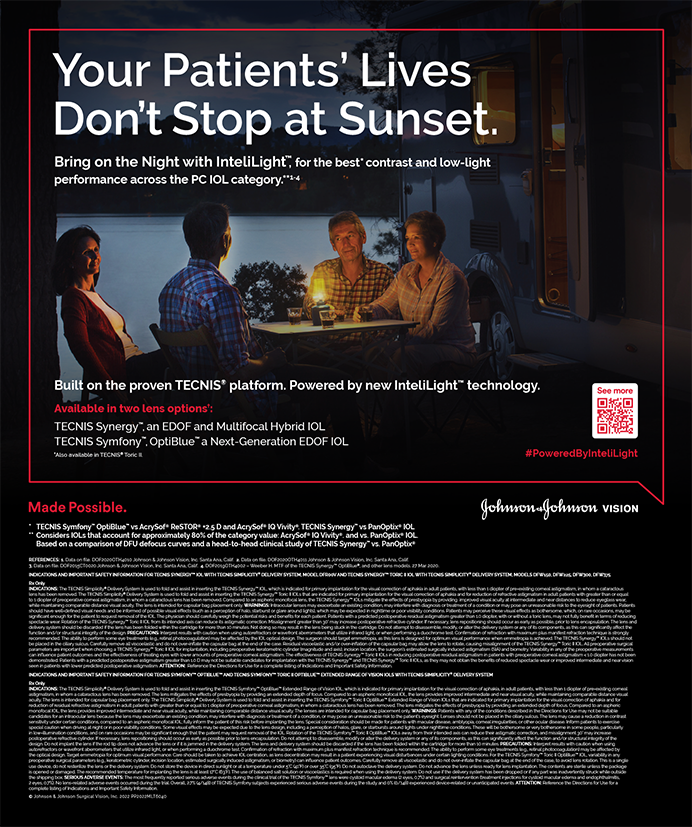

Sjögren syndrome, widely known as Sjögren’s syndrome, is a systemic autoimmune disease that affects an estimated 4 million Americans with a female-male ratio of 9:1, yet more than 75% of individuals remain undiagnosed.1 Eye care professionals are on the front lines of diagnosing and treating this disease, as 10% of patients with dry eyes have Sjögren syndrome.2
SJÖGREN SYNDROME IS MORE THAN MEETS THE EYE
Although dry eyes and mouth are hallmark symptoms of Sjögren syndrome, they are only the tip of the iceberg. This systemic, progressive, autoimmune disease can result in corneal damage, dental decay, dry skin, and vaginal dryness because of impaired exocrine gland function.1 Ninety percent of Sjögren syndrome patients develop extraglandular manifestations, which can include cranial neuropathies, peripheral neuropathies, interstitial lung disease, atrophic gastritis, hepatitis, pancreatitis, primary biliary cirrhosis, systemic sclerosis, vasculitis, renal tubular acidosis, and more.1,3
Research has shown that, when compared with individuals who do not have it, patients with Sjögren syndrome have double the risk of heart attacks,4 may have an increased risk of fetal heart block,5 and have a high frequency of comorbid Hashimoto thyroiditis, lupus, rheumatoid arthritis, and other autoimmune conditions.1,3 One study found that Sjögren syndrome patients have a 44 times higher relative risk of developing lymphoma.1 Sjögren syndrome can also have a severe impact on a patient’s quality of life.
ARE CURRENT SCREENING METHODS ADEQUATE?
Although practitioners often rely on SS-A and SS-B antibodies to screen for Sjögren syndrome, 26% to 67% of Sjögren syndrome patients do not have the SS-A antibodies, and 48% to 77% do not have the SS-B antibodies.6 SS-A/SS-B seronegative patients with suspected Sjögren syndrome should be sent for a minor salivary gland biopsy, per the American-European Consensus Classification Criteria and the American College of Rheumatology Classification Criteria.7,8 This is often not done in practice, however, because it can be difficult to find physicians with expertise in performing these biopsies and difficult to find pathologists skilled in reviewing the specimens. Moreover, some patients may be reluctant to undergo a biopsy of sensitive oral mucosa.
There is increasing recognition that the SS-A and SS-B antibodies may be present at later stages in the disease, after structural damage to the exocrine glands has occurred.9 Numerous other antibodies have been identified in Sjögren syndrome, including alpha-fodrin, muscarinic-3 receptor, tissue kallikrein, and carbonic anhydrase II antibodies, but these tests are not widely available.9
EARLY BIOMARKER TESTS ARE AVAILABLE
Researchers at the University at Buffalo set out to identify biomarkers in early Sjögren syndrome using a new mouse model of Sjögren syndrome and human studies. Their efforts resulted in the development of a panel of tests for antibodies to carbonic anhydrase-VI, parotid salivary protein, and secretory protein-1, all of which have been associated with early Sjögren syndrome.9-11 The tests are commercially available through Bausch + Lomb’s Sjö panel, with a convenient option to include SS-A, SS-B, ANA, and rheumatoid factor. Insurance often covers the panel.
Although not part of the formal Sjögren syndrome diagnostic criteria at this time, the identification of early biomarkers may open the door to treatment options for patients with clinically suspected disease. The panel may also help practitioners identify patients who should undergo a more thorough workup.
Researchers are currently exploring the role of these antibodies in early Sjögren syndrome and their response to treatment. Our group recently reported the occurrence of the early Sjögren syndrome antibodies in 41% of 95 SS-A/SS-B seronegative patients presenting with either dry eyes or dry mouth, along with one or more symptoms of neurological impairment (including numbness, tingling, burning, orthostatic intolerance, gastrointestinal dysmotility, bladder dysfunction, weakness, vestibular abnormalities, and gait impairment).12 Anecdotally, some of our patients with the early Sjögren syndrome antibodies and extensive neurological involvement responded well to intravenous immunoglobulin and/or high-dose steroids.
WHY EARLY DIAGNOSIS MATTERS
Sjögren syndrome patients experience an average diagnostic delay of 10 years.1 Early diagnosis and treatment might improve their care and quality of life, which might prevent some complications and improve long-term outcomes.
Although there is no cure for Sjögren syndrome, many treatments are available to minimize symptoms and reduce the risk of complications. Pharmacological treatments include lubricating eye drops, autologous serum eye drops and other prescription agents, punctal plugs, lubricating mouthwashes, mouth rinses to help remineralize damaged teeth, pilocarpine, cevimeline, and hydroxychloroquine. In more severe cases, immune-modulating treatments such as high-dose steroids, intravenous immunoglobulin, mycophenolate, or rituximab may be used. Treatment is highly individualized, and most pharmacological therapies are not FDA approved specifically for Sjögren syndrome. Lifestyle measures like using humidifiers and consuming an anti-inflammatory diet also play an important role in the management of the syndrome.
I (L.S.) know firsthand how important an early Sjögren syndrome diagnosis can be. I developed Sjögren syndrome acutely at age 31. Overnight, I went from being a successful lawyer and avid snowboarder to someone who could barely stand. I developed so many symptoms that my primary care doctor did not even know which specialist to send me to first. It took 2 years before someone finally tested me for Sjögren syndrome. Getting diagnosed with the disease opened the door to treatment, which helped give me my life back. I am by no means cured, but my quality of life has improved. By the time I was diagnosed, I had developed complications like dilated cardiomyopathy that might have been avoided if I had been diagnosed and treated earlier. I really want to raise awareness to help other people get diagnosed in a timely manner.
The Sjögren’s Syndrome Foundation has set a goal of cutting the average diagnostic delay in half by 2017. Eye care professionals can play a big part in reaching that goal. We want doctors to know that it is worth their time and effort to look for Sjögren syndrome in patients who present with dry eyes. Eye care providers can help patients avoid a great deal of pain and suffering and life-altering or even life-threatening complications.
CONCLUSION
Eye care professionals have a tremendous opportunity to help improve the lives of Sjögren syndrome patients, well beyond the treatment of ocular manifestations of the disease. It is important to be on the lookout for Sjögren syndrome in patients presenting with dry eye. Providers can consider using the early Sjögren syndrome biomarkers to help identify patients who may not have SS-A or SS-B but otherwise fit the clinical picture of Sjögren syndrome.
1. Kassan SS, Moutsopoulos HM. Clinical manifestations and early diagnosis of Sjögren syndrome. Arch Intern Med. 2004;164(12):1275-1284.
2. Liew M, Zhang M, Kim E, Akpek EK. Prevalence and predictors of Sjögren’s syndrome in a prospective cohort of patients with aqueous-deficient dry eye. Br J Ophthalmol. 2012;96(12):1498-1503.
3. Fauchais AL, Martel C, Gondran G, et al. Immunological profile in primary Sjögren syndrome: clinical significance, prognosis and long-term evolution to other auto-immune disease. Autoimmun Rev. 2010;9(9):595-599.
4. Yurkovich M, Sayre EC, Shojania K, Avina-Zubieta A. The risk of myocardial infarction and cerebrovascular accident in patients with Sjögren’s syndrome: a general population-based cohort study. Poster presented at: EULAR 2014; June 13, 2014; Paris, France.
5. Yildirim A, Tunaodlu FS, Karaadac AT. Neonatal congenital heart block. Indian Pediatrics. 2013;50:483-488.
6. Bournia VK, Vlachoyiannopulous G. Subgroups of Sjogren syndrome patients according to serological profiles. J Autoimmun. 2012;39:15-26.
7. Vitali C, Bombardieri S, Jonsson R, et al. Classification criteria for Sjogren’s syndrome: a revised version of the European criteria proposed by the American–European Consensus Group. Ann Rheum Dis. 2002;61:554-558.
8. Shiboski SC, Shiboski CH, Croswell LA, Baer AN. American College of Rheumatology Classification Criteria for Sjogren’s syndrome: a data-driven, expert consensus approach in the Sjogren’s International Collaborative Clinical Alliance Cohort. Arthritis Care Res. 2012;64(4):475-487.
9. Shen L, Suresh L, Lindemann M, Xuan J, et al. Novel autoantibodies in Sjogren’s syndrome. Clin Immunol. 2012;145(3):251-255.
10. Shen L, Kapsogeorgou EK, Yu M, et al. Evaluation of salivary gland protein 1 antibodies in patients with primary and secondary Sjögren’s syndrome. Clin Immunol. 2014;155(1):42-46.
11. Suresh L, Malyavantham K, Shen L, Ambrus JL. Investigation of novel autoantibodies in Sjogren’s syndrome utilizing Sera from the Sjogren’s international collaborative clinical alliance cohort. BMC Ophthalmology. 2015;15:38.
12. Gudesblatt M, Wissemann K, Stiles L, et al. Autoimmunity and autonomic impairment: preliminary characterization of a clinical syndrome with Sjogren’s features associated with novel organ specific antibodies. Neurology. 2016;78 (meeting abstracts): P5.108.
Mark Gudesblatt, MD
• medical director of the Comprehensive MS Care Center at South Shore Neurologic Associates in New York
• (631) 758-1910
• financial disclosure: has received consulting fees from Bausch + Lomb
Lauren Stiles, JD
• president of Dysautonomia International, a patient advocacy organization serving individuals diagnosed with disorders of the autonomic nervous system, including Sjögren syndrome
• lstiles@dysautonomiainternational.org
• financial disclosure: has received consulting fees from Bausch + Lomb


